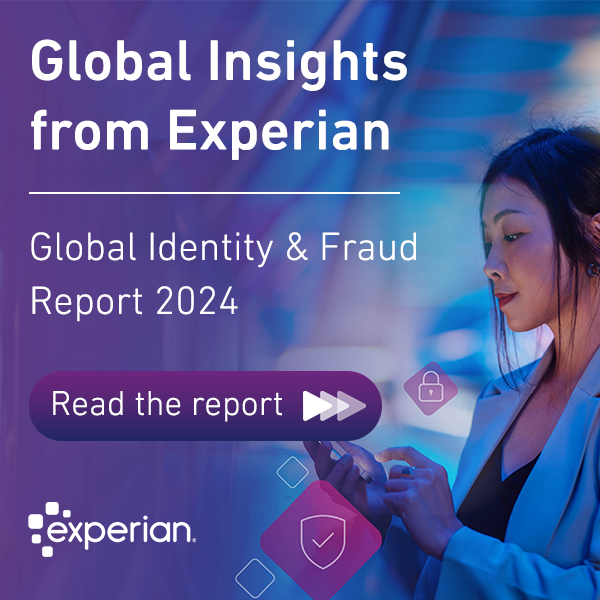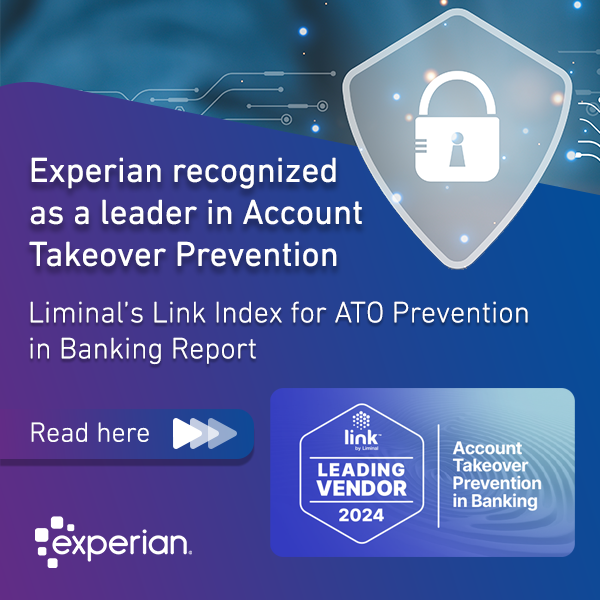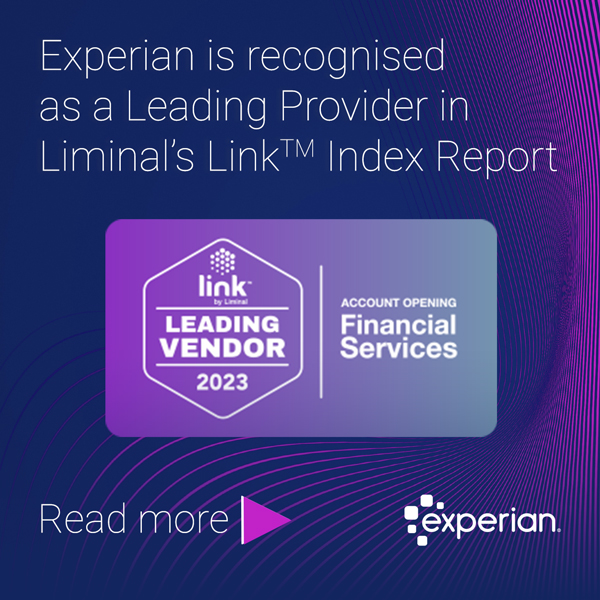Search Results for: Global Insights Report

Latest Global Insights Report: How supporting consumers in a time of uncertainty can help businesses adapt and grow A changing economic landscape needs a new approach The new digital consumer is here to stay and they expect businesses to support them with the products and services they need to navigate the rising cost of living, in a secure digital world personalised to them. Find out how: Our latest research reveals how economic uncertainty is evolving the experiences and expectations of digital consumers. From increasing the demand for credit options and financial inclusion, to deepening the need for trust, security and being seen. Read the report to find out how businesses can benefit from responding to changing consumer needs - including the additional tools and resources consumers and businesses may need to maintain financial health: What do digital consumers want? The global economy is under pressure with inflation raising prices across the world. In response, consumer behaviour is shifting, as people tackle the increased cost of living, and the prospect of an economic downturn. Digital consumers are continuing to manage their lives online and are expecting businesses to take the lead on improving the digital environment. A quality online experience is paramount, or consumers will move on. 1 in 4 businesses lost more than 10% of their customers in 2021, due to “suboptimal” digital experiences. A range of payment options including BNPL As prices rise, consumers are expecting to spend more online and are looking for varied credit options to help manage their finances. The demand for buy-now-pay-later (BNPL) options is also growing, with more consumers using BNPL to buy household staples. Consumers look favourably on companies that offer BNPL, but companies will have to find the right balance between supporting customers and managing credit risk. 32% of BNPL purchases were for groceries, up from 27% in March. Financial inclusion Economic uncertainty is accelerating the need for greater financial inclusion. Businesses need to find more creditworthy consumers and support them with responsible and sustainable products and services. 1 in 3 businesses is in the process of rolling out financial inclusion initiatives Security and trust As consumer need increases, so does fraud, including cost of living scams. Security is now a top priority for consumers around the world, alongside privacy, convenience and personalisation. 50% of consumers say they’re concerned about their online transactions. However, trust in emerging customer recognition tools is increasing, with consumers’ top three including physical biometrics, PIN codes and behavioural biometrics. Personalisation Consumers who trust businesses are more willing to share their data, enabling companies to create more personalised experiences, which in turn, improves consumer trust. 46% of consumers say that personalisation (receiving offers that fit their needs) is the most important aspect of their online experience. Read our report to discover the challenges and opportunities facing consumers and businesses and the tools, resources and strategies that can help your company get ahead. The survey results represent 6,000 consumers and 2,000 businesses across 20 countries, including Australia, Brazil, Chile, China, Columbia, Denmark, Germany, India, Indonesia, Ireland, Italy, Malaysia, Netherlands, Norway, Peru, Singapore, South Africa, Spain, UK, and US. Read our report

Latest Global Insights Report: How supporting consumers in a time of uncertainty can help businesses adapt and grow A changing economic landscape needs a new approach The new digital consumer is here to stay and they expect businesses to support them with the products and services they need to navigate the rising cost of living, in a secure digital world personalised to them. Find out how: Our latest research reveals how economic uncertainty is evolving the experiences and expectations of digital consumers. From increasing the demand for credit options and financial inclusion, to deepening the need for trust, security and being seen. Read the report to find out how businesses can benefit from responding to changing consumer needs - including the additional tools and resources consumers and businesses may need to maintain financial health. What do digital consumers want? The global economy is under pressure with inflation raising prices across the world. In response, consumer behaviour is shifting, as people tackle the increased cost of living, and the prospect of an economic downturn. Digital consumers are continuing to manage their lives online and are expecting businesses to take the lead on improving the digital environment. A quality online experience is paramount, or consumers will move on. 1 in 4 businesses lost more than 10% of their customers in 2021, due to “suboptimal” digital experiences. A range of payment options including BNPL As prices rise, consumers are expecting to spend more online and are looking for varied credit options to help manage their finances. The demand for buy-now-pay-later (BNPL) options is also growing, with more consumers using BNPL to buy household staples. Consumers look favorably on companies that offer BNPL, but companies will have to find the right balance between supporting customers and managing credit risk. 32% of BNPL purchases were for groceries, up from 27% in March. Financial inclusion Economic uncertainty is accelerating the need for greater financial inclusion. Businesses need to find more creditworthy consumers and support them with responsible and sustainable products and services. 1 in 3 businesses is in the process of rolling out financial inclusion initiatives Security and trust As consumer need increases, so does fraud, including cost of living scams. Security is now a top priority for consumers around the world, alongside privacy, convenience and personalisation. 50% of consumers say they’re concerned about their online transactions. However, trust in emerging customer recognition tools is increasing, with consumers’ top three including physical biometrics, PIN codes and behavioural biometrics. Personalisation Consumers who trust businesses are more willing to share their data, enabling companies to create more personalised experiences, which in turn, improves consumer trust. 46% of consumers say that personalisation (receiving offers that fit their needs) is the most important aspect of their online experience. Read our report to discover the challenges and opportunities facing consumers and businesses and the tools, resources and strategies that can help your company get ahead. The survey results represent 6,000 consumers and 2,000 businesses across 20 countries, including Australia, Brazil, Chile, China, Columbia, Denmark, Germany, India, Indonesia, Ireland, Italy, Malaysia, Netherlands, Norway, Peru, Singapore, South Africa, Spain, UK, and US. Download Report

The evolving expectations and experience of the new digital consumer The expectations of consumers are changing rapidly. People of all ages and incomes are online, seeking the right products and services to manage their financial lives digitally in a secure, speedy, and frictionless environment. A look inside: Our latest research reveals the rise of a new digitally savvy consumer—one who is increasingly aware of new payment methods, advanced recognition tools, and the use of AI, and has higher expectations of their digital experience. Read the report to find out what businesses can do to harness the digital opportunity: 1. Leveraging the AI advantage 2. Incorporating embedded finance 3. Introducing new, more secure technologies 4. Educating consumers about how you use their data 5. Exploring solutions that aggregate emerging technologies Online spending is continuing its upward trend, with 53% of consumers surveyed saying they have increased online spending and transactions in the past three months, and 50% predicting that their spending will increase in the next three months. Enabling this shift is the extent to which businesses can provide a quality digital experience. 81% of consumers said that a positive online experience, which includes interactions with multiple digital touchpoints makes them think more highly of a brand. Consumers simply do not tolerate poor-quality online experiences and will take their loyalty to businesses that can meet their expectations. Speed and security are a driving force for consumers in the payments space, which is reflected in rapid rise in mobile wallet payments. Rivalling traditional payment methods, 62% of consumers say they’ve used a mobile wallet in the last six months. Consumers are embracing these new habits across the board, with 18% saying they have used BNPL in the past six months, and 71% seeing it as secure. With the rise and increasing awareness of new payment methods like BNPL, consumers who have lacked access to traditional banking, lending and credit cards now have additional financial options, giving businesses the opportunity to prioritise financial inclusion. The rise of new and increased online activity has resulted in increased concerns about online security, with 42% of consumers more concerned than they were 12 months ago. With this awareness comes opportunity for businesses to leverage new recognition approaches. Biometrics seems to resonate with consumers, with 81% reporting that they feel most secure when encountering physical biometrics. Trust and security are becoming interdependent, with consumers expecting strong security measures from businesses. 73% of consumers say that the onus is on businesses to protect them online, and 45% identify the belief that businesses have strong security measures in place as the top reason to trust an online transaction. As consumers become ever-more educated and aware of the digital world, they want businesses to communicate with them about why they are using personal data. 63% of consumers are willing to share their data and see it as beneficial to them if they see security and convenience in return. We surveyed 6,000 consumers and 2,000 businesses from 20 countries worldwide as part of our ongoing efforts to learn more about how, why, and where consumers interact with businesses online. Read the full report Stay in the know with our latest research and insights:

The evolving expectations and experience of the new digital consumer

How is Covid-19 impacting digital consumer behaviour and business strategy? To find out, we surveyed 12,000 companies and 3,600 businesses across 10 countries as part of a longitudinal study that started in June 2020. Watch the video for an overview of the results or download the full report. Stay in the know with our latest research and insights: This is what we discovered: Heightened consumer expectations is paving the way for digital innovation. 59% of businesses are mostly or completely recovered from the pandemic. And 47% of consumers are somewhat or completely recovered. As economic stability returns and spending resumes. Consumers are most concerned with online security and convenience. Businesses are leveraging advanced decisioning technology to simultaneously meet security and convenience expectations. Innovative decisioning technologies across fraud and credit are improving the customer experience and levelling the playing field. With 42% of consumers happy to share personal information and adoption of AI increasing significantly across businesses – from 69% in 2020 to 74% in 2021. AI, machine learning, and advanced analytics are helping businesses of all sizes to improve: Digital decisioning Credit risk management Fraud prevention and more. Digital investment has become a differentiator - in the race to improve digital customer experience there is no standing still. Those lagging behind can lose customers and opportunities. That’s why businesses across the globe are prioritising digital engagement and digital acquisition. With 76% improving analytics models and over 60% planning to increase fraud detection and credit risk analytics budgets. Since the start of the pandemic, there has been a 25% increase in digital transactions globally. Online activity and high consumer expectations are here to stay. By adopting digital solutions that separate them from the competition, businesses can thrive in 2022. Watch the video for an overview of the results or download the full report.

Businesses with priorities to acquire and retain customer loyalty should be prioritizing technology investments that improve the digital customer experience as well as prevent fraud and better manage consumer credit risk. In our latest survey of consumers globally, we found that the increase in online activity between June and October 2020 has sustained itself for the past year with little sign of digital fatigue. Consumers report that they’re online 25% more today than they were just a year ago. Many lenders and retailers have transformed their operations and met consumers’ needs for accessing goods and services online throughout the pandemic; however, customer expectations for their digital experience may be outpacing those efforts. Our same study found that customer loyalty toward businesses during the pandemic was at an all time high, but now starting to slip. 61% of consumers reported continuing to engage with the same companies they did a year ago, down 6% in twelve months. Consumers cite security, privacy, and convenience as their top priorities for engaging online. As companies adopt more digital processes and automation to deliver on the real-time financial transactions of their customers, they’re looking to access advanced capabilities for more accurate fraud prevention and credit risk management. Globally, the adoption of artificial intelligence in credit risk decisions is trending up, and 60% of businesses intend on increasing their analytics budgets. Similarly, 65% of companies are increasing their fraud prevention Scalable solutions are creating opportunities for businesses of all sizes to compete for the digital customer. What this means to a mid-size bank, credit union, building society, Fintech and neo-bank is greater accessibility to cloud-based credit risk decision management software. Decades of decisioning best practices coupled with leading edge analytics and technology can help more companies achieve their growth ambitions by attracting, acquiring, and engaging more customers. In fact, confidence in on-demand, cloud-based decisioning has grown to 81%, up from 72% in the past twelve months. Access more insights from our latest research here Other key insights: Consumers report that they are online 25% more now than they were just a year ago 42% of consumers have increased concern for the safety banking and shopping transactions 61% of consumers say they’re transacting with the same businesses, down 6% from last year Consumers rank their priorities online: security #1, privacy #2, convenience #3 Business adoption of advanced analytics has increased over last year – AI is up from 69% to 74% Confidence in on-demand, cloud-based credit risk decisioning is trending up from 72% to 81% Businesses globally say improving digital engagement and customer acquisition is their top priority 75% of consumers feel the most secure using physical biometrics #1 Digital investment is decisioning software, followed by AI and digital enablement for staff Businesses plan to increase budgets for fraud prevention (65%) and consumer credit analytics (60%) In our latest research, we surveyed 3,000 consumers and 900 businesses across Australia, Brazil, Germany, India, Italy, Japan, Singapore, Spain, United Kingdom, and United States. This report is part of a longitudinal study and published series that started in June 2020 through October 2021 exploring the major shifts in consumer behavior and business strategy throughout Covid-19. Stay in the know with our latest research and insights:

The world is still grappling with the mental, emotional, and financial toll of the Covid-19 pandemic but there are clear signs of hope and resolution ahead. Consumer concerns about their personal finances have started to ease for the first time since June 2020. And there’s a groundswell of opportunity for businesses to serve the growing ranks of “connected customers”—putting the consumer truly at the heart of the relationship. Download Global Insights Report – January/February 2021 issue Key insights: 60% of consumers are using a universal mobile wallet - for online and/or in-person contactless transactions Top 2 activities among consumers online are personal banking (58%) and ordering groceries and takeout food (56%) 90% of businesses have a strategy in place related to the digital customer journey; 47% of businesses put this strategy into place since Covid-19 41% of businesses intend to use AI to acquire and onboard new customers 55% of consumers say security is the most important factor in their digital experience – this is highest in the UK (65%), followed by Japan (64%) Fraud is the biggest challenge among businesses; 55% of businesses plan to increase fraud management budgets In this report, we continue our examination of consumer behavior and business strategy throughout the pandemic. For our third wave of insights, we surveyed 3,000 consumers and 900 businesses in January 2021. Our respondents span 10 countries, including Australia, Brazil, France, Germany, India, Japan, Singapore, Spain, the United Kingdom, and the United States. Over the past 12 months, we’ve observed consumer demand for the digital channel increase at a rate that few could have predicted. The most recent survey shows that these trends are persisting. Looking ahead, we expect that as people get more comfortable with the security and convenience of the digital channel, it will become the preferred—if not permanent—way to bank and shop. Part of what’s driving the continued demand: Positive digital experiences. Most consumers report they’ve been satisfied with their online transactions, especially when they secure and their financial information is protected. This is remarkable, given the challenges businesses faced to meet online demand while simultaneously adapting their employee and customer operations to the crisis. Businesses rose to the occasion and there’s opportunity ahead. Our latest report reveals that consumer expectations for digital experiences continue to rise. For example, even as consumers enjoy the ease of online banking and shopping, security is top-of-mind. In response, businesses are renewing their focus on preventing and mitigating account takeover fraud, transactional fraud, and digital takeaway fraud (e.g. buy online and pick up in-store). And they’re looking for solutions they can use throughout the digital customer journey, not just account opening. Consumers are also looking for greater customer support across digital channels. For example, when a customer is engaging with a business digitally, access to customer service is essential. It’s also an area where many businesses are falling short. However, businesses have made redefining the customer journey a priority and they're investing in capabilities, such as artificial intelligence and automation, to deliver on customer expectations. Consumers and businesses have embraced the digital channel— and the promise it offers is only growing. Now as we move toward a new, post-pandemic era, organizations that re-imagine the customer journey and create digital experiences that place customers at the center stand to win. find out what businesses are using to help improve the customer journey across digital channels, as they prepare for post-Covid customer engagements.

By leveraging insights from leading industry analysts, Experian's expertise, extensive market studies, and market sentiment, we identified four key themes shaping the financial services sector this year. Read now Four themes impacting financial services this year: 1. Fraud evolution driven by AI Tracking synthetic identities is a big challenge for FIs in 2025, exacerbated by fraudsters' use of Gen AI tools to scale activities. Investment in AI is a growing priority as banks seek to strengthen identity verification. Account takeover (ATO) and Authorised Push Payment Fraud (APP) are also growing problems very much linked to advanced AI methods employed by criminals. Collaboration across institutions and the adoption of advanced analytics will be critical in staying ahead of fraudsters. 2. Advanced AI will improve operational efficiencies in new ways GenAI and Agentic AI (an orchestration tool connecting multiple AI models) are unlocking new levels of efficiency and personalisation. The emphasis on adoption is twofold: first, automating steps to accelerate development and delivery, and second, ensuring transparency, compliance, and governance. Businesses need to take an incremental approach to GenAI adoption, with centralised governance and a focus on explainability. AI will improve mid-office processes where internal manual inefficiencies impact downstream customer interactions. 3. Emergence of RegTech to meet complexities of compliance Heightened regulatory scrutiny is driving the adoption of innovative compliance technologies. Adopting cloud-native, modular systems supports more agile compliance strategies and reduces the cost and complexity of updating solutions. Explainable AI is increasingly essential for demonstrating compliance and fostering regulator confidence in automated decision-making. 4. Convergence of risk management The integration of fraud prevention, credit risk assessment, and compliance is a growing trend among financial institutions. Digital identity frameworks and unified data analytics are becoming essential for holistic risk management. Banks need to embrace collaborative approaches and consortium-level partnerships to address interconnected challenges. Read the report




